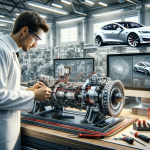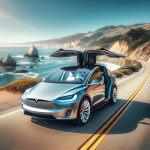Tesla‘s Full Self-Driving (FSD) technology recently achieved a significant milestone, surpassing over one billion cumulative miles driven by Tesla users. This accomplishment highlights the growing adoption and utilization of autonomous driving capabilities in Tesla vehicles, underscoring the company’s commitment to advancing the technology.
The journey towards autonomous driving has been marked by incremental progress rather than revolutionary leaps. In this context, Tesla’s announcement of surpassing one billion miles on its Full Self-Driving system represents a considerable aggregate of user experience and data collection. This milestone is reflective of the company’s iterative approach to enhancing its Autopilot and Full Self-Driving features over time. Historically, Tesla has consistently rolled out software updates to improve functionality and safety, an approach that has allowed it to amass a significant amount of driving data compared to its competitors. Such extensive real-world mileage not only contributes to the refinement of Tesla’s self-driving algorithms but also provides a substantial dataset that could potentially accelerate the progress towards full autonomy.
Competition in the Autonomous Driving Arena
Tesla’s recent milestone of one billion miles driven with FSD technology positions it prominently within the competitive landscape of autonomous driving. This achievement is particularly noteworthy when compared with other companies in the space. For instance, Waymo reported over 7 million miles in rider-only trips by the end of 2023, while Cruise achieved 3 million driverless miles by mid-2023. Tesla’s one billion miles speak to the scale of its user base and the extensiveness of its data collection efforts within the autonomous driving sector.
Driving Forward with Full Self-Driving Initiatives
Tesla’s continuous push to enhance the FSD experience comes with the recent release of FSD (Supervised) V12.3 to consumers. The company has integrated a test drive featuring the advanced driver-assist system into the customer vehicle delivery process. Moreover, Tesla introduced a free FSD (Supervised) trial for eligible vehicles, potentially catalyzing a further increase in the FSD program’s cumulative miles. These strategic moves aim to familiarize more customers with the FSD technology and ensure its continuous improvement through feedback and real-world usage.
To provide additional context, CNET’s article “Tesla’s bet on FSD: A look at Autopilot’s evolution” delves into the history and development of Tesla’s Autopilot and Full Self-Driving features. It outlines the series of improvements and the public’s response to these advancements. Another relevant piece, from The Verge, titled “The Road to Full Autonomy: Tesla and the Competition,” compares Tesla’s efforts with those of other industry players, providing insight into how Tesla’s approach to data collection and software updates differs from rivals.
Regulatory Hurdles and Future Milestones
While reaching one billion miles is a testament to Tesla’s progress, the company recognizes the road to worldwide regulatory acceptance of fully autonomous vehicles is long. Tesla’s own estimates suggest that achieving global regulatory approval may require an order of magnitude more miles, specifically around 6 billion. Nonetheless, with an expanding fleet of vehicles and the continuous accumulation of data, attaining such milestones appears increasingly feasible.
Useful Information for the Reader
- Tesla’s vast data from FSD miles enhances algorithm refinement.
- Comparison with competitors underscores Tesla’s leading position.
- Regulatory approval may necessitate six times the current FSD mileage.
Tesla’s milestone of one billion FSD miles is not just a numeric triumph; it is indicative of a maturing technology that is poised to redefine our transportation paradigms. As the technology evolves, customers can expect ongoing improvements in the reliability and functionality of the FSD system. Moreover, the amassed driving data is a critical asset in navigating the road to full autonomy and shaping the interactions between vehicles, drivers, and the broader transportation infrastructure.










